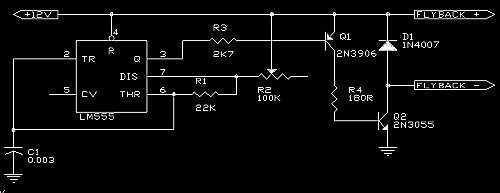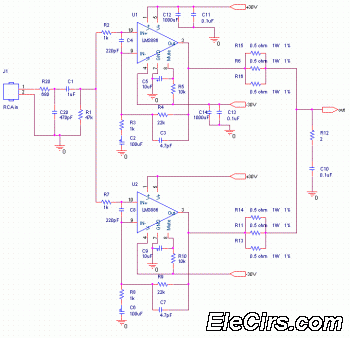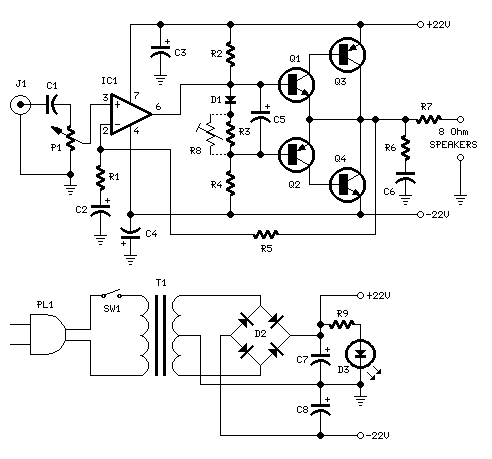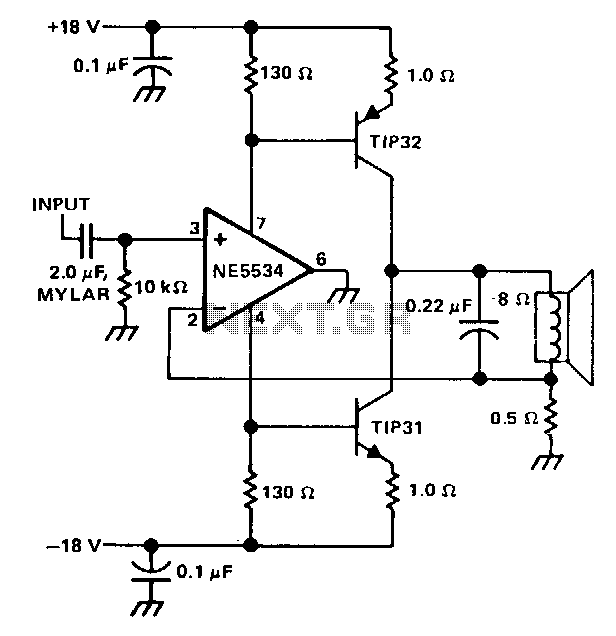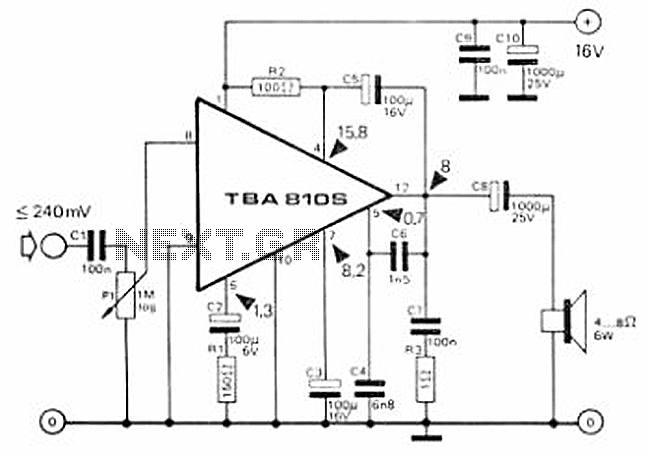
Changes to the MXMs Audio Signal Path
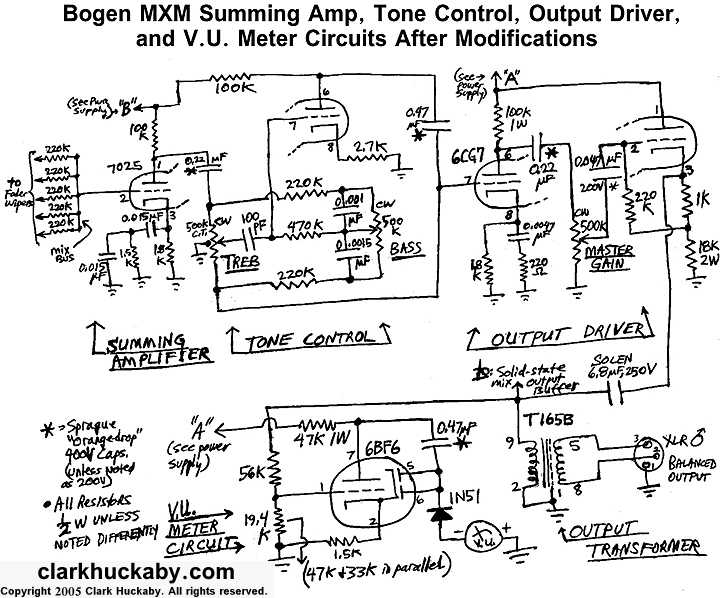
The block diagrams presented in Figure 1 indicate that the overall signal flow in this five-input mixer underwent minimal changes following modifications. Solid-state buffers were added to provide independent direct outputs for the five preamp channels. The audio signal for each channel's op-amp-based buffer is derived from the wiper of the channel fader. Consequently, channel faders are utilized to adjust direct output levels concurrently with relative mix levels in the modified MXM. The channel output buffers were designed with high impedance inputs (1 M-ohm) to minimize loading on the preceding tube preamp stages (refer to Figure 10). Other alterations to the signal path, as shown in the block diagrams (Figure 1), include: (1) simplification of Channel 1's input options, and (2) removal of the original "high-impedance" unbalanced mix output, replaced with a solid-state output buffer. These modifications are elaborated upon below. As part of an overall enhancement to the MXM's signal path, all original coupling capacitors were replaced; Sprague "Orange Drop" polypropylene film units were predominantly chosen for their musicality (notably illustrated in Figure 3, bottom). Initially, Channel 1 featured a three-position screwdriver-slotted rotary switch on the front panel to select between microphone, phonograph, and auxiliary inputs. Figure 5 illustrates that this three-pole (3P3T) switch not only selected the input coupling but also altered filters within a feedback network (between 7025 triode stages) to add equalization (EQ) for the phono setting. Passive filter networks at the "magnetic" and "crystal" phono inputs provided additional EQ for various 1960s-era phono cartridges. Given that this EQ is considered obsolete by modern standards, as are monaural phonographs, it was decided to eliminate all EQ in this channel rather than attempting to reconstruct it. A third setting of Channel 1's input selector switch completely bypassed the preamp, allowing the auxiliary input jack to connect directly to the top of the channel fader. Due to anticipated limited use, this feature was removed for the sake of simplicity. Figure 7 (top) presents a schematic of Channel 1 following modifications. The 3P3T switch and phono EQ circuitry were replaced with a SPDT toggle that selects between a transformer-coupled mic input and a 1/4-inch line input. The feedback network between the 7025 triode stages remains unchanged from the original design when the microphone option is selected, resulting in a flat audio frequency response as the sole option in the modified channel. A Neutrik 1/4-inch jack provides a "line" input when selected by the toggle switch, isolated with a series 33 K-ohm resistor for stability. The 1-M-ohm grid resistor at pin 7 of the 7025 tube ensures a ground path for any grid current and sets the input impedance of the line input to 1 M-ohm. To accommodate this added resistor, the microphone transformer’s load resistor was adjusted from 100 to 111 K-ohm, ensuring that the equivalent mic input circuits of Channel 1's original and modified designs remain identical. After modifications, the microphone input impedance for this channel was measured at 320 ohms. Aside from upgrading the coupling capacitors, the design of these pentode-based mic preamp channels was retained from the original MXM (comparison of the post-modification schematic in Figure 7 [bottom] with the original schematic in Figure 5). However, the 9-pin "remote control" jack and its wiring to the pentodes' second grids were eliminated due to its obsolescence and potential to act as a noise antenna. Testing of the completed project revealed that input impedances for these channels measured exactly 150 ohms. Figure 8 displays a schematic of the MXM's remaining tube audio circuits after the modifications. As detailed below, an op-amp-driven line output was substituted for the original "high impedance" master channel output. Other than upgrading capacitors, this section of the design was not altered.
The five-input mixer design incorporates a series of enhancements aimed at modernizing the audio signal path while maintaining the integrity of the original circuitry. The introduction of solid-state buffers ensures that each preamp channel can deliver a direct output without compromising the performance of the preceding tube stages. The high input impedance of 1 M-ohm for the output buffers is crucial for preserving signal fidelity and minimizing interaction with the tube preamps.
The modifications to Channel 1 illustrate a significant simplification in the input selection process. The removal of the rotary switch and phono EQ circuitry reflects a shift towards a more streamlined design, focusing on the most relevant input options for contemporary users. By replacing the complex input switching mechanism with a straightforward toggle switch, the design not only enhances usability but also reduces potential points of failure.
The choice of capacitors for coupling applications is critical in audio circuits, and the selection of Sprague "Orange Drop" polypropylene film capacitors highlights a commitment to quality components known for their acoustic properties. This choice is particularly relevant in the context of audio applications where fidelity and tonal characteristics are paramount.
The adjustments made to the microphone input circuitry ensure compatibility with modern microphones while retaining the original design's performance characteristics. By measuring and confirming input impedances, the modifications can be validated against original specifications, ensuring that the mixer meets contemporary standards without sacrificing its vintage appeal.
Overall, these enhancements reflect a careful balance between modernization and respect for the original design, ensuring that the mixer remains relevant in today's audio landscape while retaining its historical significance.As shown by the block diagrams in Figure 1, overall signal flow in this five-input mixer was minimally changed upon modification, but I added solid-state buffers that drive independent direct outputs for the five preamp channels. For each channel, the audio signal for the respective op amp-based buffer is taken from the channel fader`s wiper.
Thu s, channel faders are used to set direct output levels concurrently with relative mix levels in the modified MXM. I designed the channel output buffers to have high impedance inputs (1 M-ohm), which minimally load the preceding tube preamp stages (see below and Figure 10 ).
Other changes to the signal path visible by comparing the block diagrams ( Figure 1 ) are: (1) simplification of Channel 1`s input options, and (2) elimination of the original "high-impedance" unbalanced mix output, with use of a solid-state output buffer instead. I present these modifications in greater detail below. As an overall upgrade to the MXM`s signal path, I replaced all of the original coupling capacitors. In most cases I chose Sprague "Orange Drop" polypropylene film units (this is most apparent in Figure 3, bottom), which are famous for their musicality.
Originally, Channel 1 had a three-position screwdriver-slotted rotary switch on the front panel to select between microphone, phonograph and auxiliary inputs. As seen in Figure 5, this three-pole (3P3T) switch not only selected the input coupling, but also swapped filters within a feedback network (between 7025 triode stages) to add equalization (EQ) for the phono setting.
Passive filter networks at the "magnetic" and "crystal" phono inputs contributed additional EQ for the different 1960s-era phono cartridges. This EQ is obsolete by modern standards, as are monaural phonographs. I therefore eliminated all EQ in this channel rather than attempting to rebuild it. A third setting of Channel 1`s input selector switch completely bypassed the preamp, coupling the auxiliary input jack directly to the top of the channel fader.
Not anticipating much use for this, I opted to eliminate this luxury for simplicity`s sake. Figure 7 (top) shows a schematic of Channel 1 after my modifications. The 3P3T switch and phono EQ circuitry is replaced by a SPDT toggle that simply selects between a transformer-coupled mic input and a 1/4-inch line input. The feedback network between 7025 triode stages is identical to that of the original design when the microphone option was selected.
It results in a flat audio frequency response as the sole option in the modified channel. A Neutrik 1/4-inch jack provides a "line" input when selected by the toggle switch, and is isolated with a series 33 K-ohm resistor for stability. The 1-M-ohm grid resistor at pin 7 of the 7025 tube insures a ground path for any grid current, and also sets the input impedance of the line input to 1 M-ohm.
Accounting for this added resistor, I changed the microphone transformer`s load resistor from 100 to 111 K-ohm, so the equivalent mic input circuits of Channel 1`s original and modified designs are identical. After modification, I measured this channel`s microphone input impedance as 320 ohms. Aside from upgrading their coupling capacitors, I left the design of these pentode-based mic preamp channels the same as in the original MXM (compare the post-modification schematic in Figure 7 [bottom] with the original schematic in Figure 5 ).
However, I eliminated the 9-pin "remote control" jack and its wiring to the pentodes` second grids. This obsolete feature could only be a noise antenna now. On testing the completed project, input impedances for these channels measured exactly 150 ohms. Figure 8 shows a schematic of the MXM`s remaining tube audio circuits after modification. As detailed below, I substituted an op-amp-driven line output for the original "high impedance" master channel output. Otherwise, I upgraded capacitors without altering this se 🔗 External reference
The five-input mixer design incorporates a series of enhancements aimed at modernizing the audio signal path while maintaining the integrity of the original circuitry. The introduction of solid-state buffers ensures that each preamp channel can deliver a direct output without compromising the performance of the preceding tube stages. The high input impedance of 1 M-ohm for the output buffers is crucial for preserving signal fidelity and minimizing interaction with the tube preamps.
The modifications to Channel 1 illustrate a significant simplification in the input selection process. The removal of the rotary switch and phono EQ circuitry reflects a shift towards a more streamlined design, focusing on the most relevant input options for contemporary users. By replacing the complex input switching mechanism with a straightforward toggle switch, the design not only enhances usability but also reduces potential points of failure.
The choice of capacitors for coupling applications is critical in audio circuits, and the selection of Sprague "Orange Drop" polypropylene film capacitors highlights a commitment to quality components known for their acoustic properties. This choice is particularly relevant in the context of audio applications where fidelity and tonal characteristics are paramount.
The adjustments made to the microphone input circuitry ensure compatibility with modern microphones while retaining the original design's performance characteristics. By measuring and confirming input impedances, the modifications can be validated against original specifications, ensuring that the mixer meets contemporary standards without sacrificing its vintage appeal.
Overall, these enhancements reflect a careful balance between modernization and respect for the original design, ensuring that the mixer remains relevant in today's audio landscape while retaining its historical significance.As shown by the block diagrams in Figure 1, overall signal flow in this five-input mixer was minimally changed upon modification, but I added solid-state buffers that drive independent direct outputs for the five preamp channels. For each channel, the audio signal for the respective op amp-based buffer is taken from the channel fader`s wiper.
Thu s, channel faders are used to set direct output levels concurrently with relative mix levels in the modified MXM. I designed the channel output buffers to have high impedance inputs (1 M-ohm), which minimally load the preceding tube preamp stages (see below and Figure 10 ).
Other changes to the signal path visible by comparing the block diagrams ( Figure 1 ) are: (1) simplification of Channel 1`s input options, and (2) elimination of the original "high-impedance" unbalanced mix output, with use of a solid-state output buffer instead. I present these modifications in greater detail below. As an overall upgrade to the MXM`s signal path, I replaced all of the original coupling capacitors. In most cases I chose Sprague "Orange Drop" polypropylene film units (this is most apparent in Figure 3, bottom), which are famous for their musicality.
Originally, Channel 1 had a three-position screwdriver-slotted rotary switch on the front panel to select between microphone, phonograph and auxiliary inputs. As seen in Figure 5, this three-pole (3P3T) switch not only selected the input coupling, but also swapped filters within a feedback network (between 7025 triode stages) to add equalization (EQ) for the phono setting.
Passive filter networks at the "magnetic" and "crystal" phono inputs contributed additional EQ for the different 1960s-era phono cartridges. This EQ is obsolete by modern standards, as are monaural phonographs. I therefore eliminated all EQ in this channel rather than attempting to rebuild it. A third setting of Channel 1`s input selector switch completely bypassed the preamp, coupling the auxiliary input jack directly to the top of the channel fader.
Not anticipating much use for this, I opted to eliminate this luxury for simplicity`s sake. Figure 7 (top) shows a schematic of Channel 1 after my modifications. The 3P3T switch and phono EQ circuitry is replaced by a SPDT toggle that simply selects between a transformer-coupled mic input and a 1/4-inch line input. The feedback network between 7025 triode stages is identical to that of the original design when the microphone option was selected.
It results in a flat audio frequency response as the sole option in the modified channel. A Neutrik 1/4-inch jack provides a "line" input when selected by the toggle switch, and is isolated with a series 33 K-ohm resistor for stability. The 1-M-ohm grid resistor at pin 7 of the 7025 tube insures a ground path for any grid current, and also sets the input impedance of the line input to 1 M-ohm.
Accounting for this added resistor, I changed the microphone transformer`s load resistor from 100 to 111 K-ohm, so the equivalent mic input circuits of Channel 1`s original and modified designs are identical. After modification, I measured this channel`s microphone input impedance as 320 ohms. Aside from upgrading their coupling capacitors, I left the design of these pentode-based mic preamp channels the same as in the original MXM (compare the post-modification schematic in Figure 7 [bottom] with the original schematic in Figure 5 ).
However, I eliminated the 9-pin "remote control" jack and its wiring to the pentodes` second grids. This obsolete feature could only be a noise antenna now. On testing the completed project, input impedances for these channels measured exactly 150 ohms. Figure 8 shows a schematic of the MXM`s remaining tube audio circuits after modification. As detailed below, I substituted an op-amp-driven line output for the original "high impedance" master channel output. Otherwise, I upgraded capacitors without altering this se 🔗 External reference
